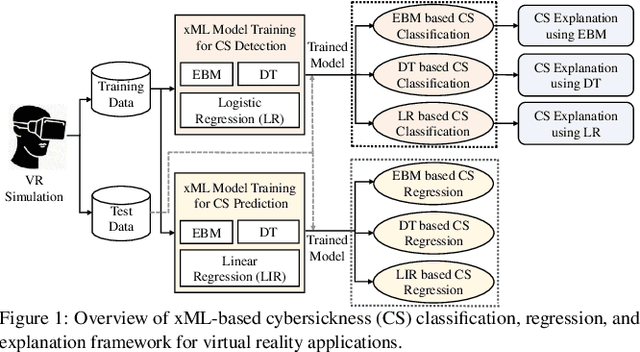Rifatul Islam
LiteVR: Interpretable and Lightweight Cybersickness Detection using Explainable AI
Feb 05, 2023Abstract:Cybersickness is a common ailment associated with virtual reality (VR) user experiences. Several automated methods exist based on machine learning (ML) and deep learning (DL) to detect cybersickness. However, most of these cybersickness detection methods are perceived as computationally intensive and black-box methods. Thus, those techniques are neither trustworthy nor practical for deploying on standalone energy-constrained VR head-mounted devices (HMDs). In this work, we present an explainable artificial intelligence (XAI)-based framework, LiteVR, for cybersickness detection, explaining the model's outcome and reducing the feature dimensions and overall computational costs. First, we develop three cybersickness DL models based on long-term short-term memory (LSTM), gated recurrent unit (GRU), and multilayer perceptron (MLP). Then, we employed a post-hoc explanation, such as SHapley Additive Explanations (SHAP), to explain the results and extract the most dominant features of cybersickness. Finally, we retrain the DL models with the reduced number of features. Our results show that eye-tracking features are the most dominant for cybersickness detection. Furthermore, based on the XAI-based feature ranking and dimensionality reduction, we significantly reduce the model's size by up to 4.3x, training time by up to 5.6x, and its inference time by up to 3.8x, with higher cybersickness detection accuracy and low regression error (i.e., on Fast Motion Scale (FMS)). Our proposed lite LSTM model obtained an accuracy of 94% in classifying cybersickness and regressing (i.e., FMS 1-10) with a Root Mean Square Error (RMSE) of 0.30, which outperforms the state-of-the-art. Our proposed LiteVR framework can help researchers and practitioners analyze, detect, and deploy their DL-based cybersickness detection models in standalone VR HMDs.
TruVR: Trustworthy Cybersickness Detection using Explainable Machine Learning
Sep 12, 2022



Abstract:Cybersickness can be characterized by nausea, vertigo, headache, eye strain, and other discomforts when using virtual reality (VR) systems. The previously reported machine learning (ML) and deep learning (DL) algorithms for detecting (classification) and predicting (regression) VR cybersickness use black-box models; thus, they lack explainability. Moreover, VR sensors generate a massive amount of data, resulting in complex and large models. Therefore, having inherent explainability in cybersickness detection models can significantly improve the model's trustworthiness and provide insight into why and how the ML/DL model arrived at a specific decision. To address this issue, we present three explainable machine learning (xML) models to detect and predict cybersickness: 1) explainable boosting machine (EBM), 2) decision tree (DT), and 3) logistic regression (LR). We evaluate xML-based models with publicly available physiological and gameplay datasets for cybersickness. The results show that the EBM can detect cybersickness with an accuracy of 99.75% and 94.10% for the physiological and gameplay datasets, respectively. On the other hand, while predicting the cybersickness, EBM resulted in a Root Mean Square Error (RMSE) of 0.071 for the physiological dataset and 0.27 for the gameplay dataset. Furthermore, the EBM-based global explanation reveals exposure length, rotation, and acceleration as key features causing cybersickness in the gameplay dataset. In contrast, galvanic skin responses and heart rate are most significant in the physiological dataset. Our results also suggest that EBM-based local explanation can identify cybersickness-causing factors for individual samples. We believe the proposed xML-based cybersickness detection method can help future researchers understand, analyze, and design simpler cybersickness detection and reduction models.
 Add to Chrome
Add to Chrome Add to Firefox
Add to Firefox Add to Edge
Add to Edge